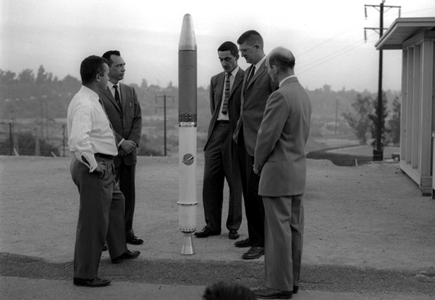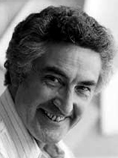
Al Hibbs (1924-2003)
Scientist, "The Voice of JPL" - "The Voice of JPL"
Al Hibbs decided as a five-year-old that he wanted to go to the moon. He did qualify as an astronaut in 1967, even though he was seven years over the age limit. He was slated to fulfill his dream, but unfortunately the program ended with Apollo 17 before he got his mission assignment.
As a student at the California Institute of Technology (Caltech), Hibbs studied physics under the Navy's V-12 program, and he earned his bachelor's degree in physics there in 1945. In the late 1940s, while in graduate school at the University of Chicago, Hibbs and his then roommate Roy Walford took some time off to "break the bank" in Reno and Las Vegas by exploiting the mechanical quirks of certain roulette wheels. This earned them a story in Life magazine. Their winnings financed a 40-foot sailboat and a year and a half of roaming the Caribbean. Hibbs obtained a master's degree in mathematics from the University of Chicago in 1947.

Roy Walford went on to become a leading gerontologist and Hibbs became a leader in exploring our solar system, as well as the "Voice of JPL." "I wanted to conquer space. And my roommate, Roy Walford, decided that he would conquer death. Together we would then conquer time," Hibbs later wrote.
Hibbs joined the Jet Propulsion Laboratory (JPL) in February 1950. As JPL's head of the Research and Analysis Section, he was the systems designer for America's first successful satellite, Explorer 1, in 1958.
Later that year, when JPL became part of the newly formed NASA, Hibbs helped draw up JPL's master plan to explore the solar system with unmanned spacecraft. His gift for explaining difficult science in lay terms led to his position as the radio and television chronicler for the Ranger and Surveyor missions to the Moon in the 1960s; the Mariner missions to Venus, Mars and Mercury in the 1960s and 1970s; the Viking missions to Mars in the 1970s; and the Voyager missions to the outer solar system in the 1970s and 1980s.
After helping to set up JPL's Space Science Division from 1960 to 1962, and serving as its first chief, Hibbs went on loan as a staff scientist for the United States Arms Control and Disarmament Agency, studying how arms control treaties could be monitored from space. Five years later, he returned to JPL, where he spent the rest of his career working in a variety of technology programs, earning NASA's Exceptional Service Award and the NASA Achievement Award in the process.
He retired in 1986, three years before Voyager 2 reached Neptune.
Hibbs maintained close ties with Caltech, where over the years he taught courses in government, national security, transportation issues and physics. He took time off from JPL to earn his Ph.D. there (1955), supported by his wife, the late Florence Pavin. His advisor was Richard Feynman, and the two became close friends. They co-wrote "Quantum Mechanics and Path Integrals," a standard text on the subject, and Hibbs wrote the foreword "Surely You're Joking, Mr. Feynman."
He also hosted and narrated various programs for NBC and PBS, winning a Peabody in 1963 for the four-year NBC children's series, "Exploring."
Hibbs died in 2003 following complications from heart surgery. He was 78.
Planetary science is a global profession.

